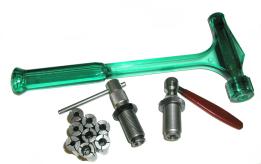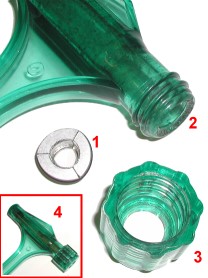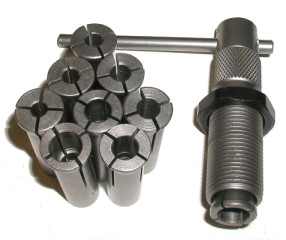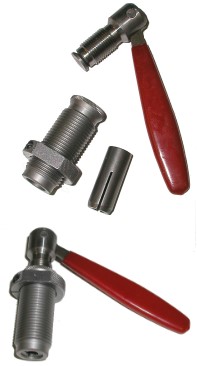 Handloading is a precise endeavor. At 7,000 grains to a pound, shifts as small as 10 grains of powder or bullet weight could carry serious consequences. If I discover a scale has gone out of calibration half way through a batch of handloads, if I hesitate because my eyes might have followed the wrong charge data line on a load table, or if I open a box of old handloads and find there is no relevant data sheet, I disassemble the questionable ammo. Nothing complex here, a very basic process to the handloader, but there are a few possible approaches.
Handloading is a precise endeavor. At 7,000 grains to a pound, shifts as small as 10 grains of powder or bullet weight could carry serious consequences. If I discover a scale has gone out of calibration half way through a batch of handloads, if I hesitate because my eyes might have followed the wrong charge data line on a load table, or if I open a box of old handloads and find there is no relevant data sheet, I disassemble the questionable ammo. Nothing complex here, a very basic process to the handloader, but there are a few possible approaches.
The most common tool for disassembly non-rim fire ammo is the kinetic or inertial bullet puller. These tools are inexpensive at about $15, long lasting, easy to use, and work with a wide array of cartridges. In use, the loaded cartridge is slipped into the collet #1, dropped into the bullet puller body #2, secured with screw on cap #3, until it looks like #4. Then the opposite end of the puller head is whacked on a solid surface.
The case, supported by the collect, tends to stop abruptly with the bullet puller body on impact. The bullet and powder in side the case, which are unsupported, tend to want to continue on after all else has stopped. After a couple of sharp raps, the bullet falls free, the powder follows, both trapped in side the puller body until the screw cap is removed and the components are emptied.
The downside is this type of puller can be messy and contaminate powder when mixed with residue of different types, and they usually won’t fit very large cases (i.e. 378 Weatherby).
 Not rocket science, but reliable, more sanitary in handling components on disassembly, and won’t damage bullets; the RCBS collet bullet puller.
Not rocket science, but reliable, more sanitary in handling components on disassembly, and won’t damage bullets; the RCBS collet bullet puller.The puller screws into an open reloading press die station, the cartridge is placed in the shell holder on the press ram, the press ram is raised until the bullet enters the collet just before the case neck, the cross bar handle on the puller is turned until the collet closes and locks firmly onto the bullet. Then the ram is lowered pulling the case away from the bullet which is retained by the collet.
Collet pullers are more costly. The base puller runs about $16, the collets about $7 per and it is one collet per caliber. I’ve used mine for some time, moving away from the mess of separating powder and bullets from an inertial puller, at least anytime there is more than one or two case to disassemble. The only problem with this particular puller is that if it is used in a multiple die head set up, turret press, ammo master, Pro, etc. the handle hits the adjacent die body when it is rotated to lock the collet. In real use, I knocked the handle out of its serrated through hole with a hammer, and use the smooth end like a key. No big deal.
 As part of my effort toward being exposed to all things not RCBS, I picked up a Hornady Puller, a Hornady Cam-Lock Bullet Puller and Collet to be more specific, for the .270 WSM project. Looking at that handle, referencing the term Cam-Lock, and reading the product description, you might think the handle rotates and cams the collet open and closed – it does. Generally, it operates as the RCBS unit, except when used with a removal run of the same type bullet, the die can be set close in adjustment, and the red lever will cam over to open the collet enough for bullet removal without backing out die adjustment. I was not able to adjust close enough to use the cam feature and still be able to pull removed bullets from the collet with my fingers.
As part of my effort toward being exposed to all things not RCBS, I picked up a Hornady Puller, a Hornady Cam-Lock Bullet Puller and Collet to be more specific, for the .270 WSM project. Looking at that handle, referencing the term Cam-Lock, and reading the product description, you might think the handle rotates and cams the collet open and closed – it does. Generally, it operates as the RCBS unit, except when used with a removal run of the same type bullet, the die can be set close in adjustment, and the red lever will cam over to open the collet enough for bullet removal without backing out die adjustment. I was not able to adjust close enough to use the cam feature and still be able to pull removed bullets from the collet with my fingers.The Cam Lock did not work with Hornady’s Lock-N-Load bushings. I could tighten the collet and clamp the bullet, however, when attempting to rotate the handle counter clock wise to release the bullet from the collet, the Lock-N-Load bushing was unscrewed from the press, leaving me with puller, bushing and firmly clamped bullet in hand. Maybe if I could get the cam release to work more consistently this would not be the case, however, I just couldn’t get a point of adjustment where the cam lever was able to tighten and release a bullet, without altering the puller’s position in the press.
 For those of you who are unfamiliar with the quick release Hornady Lock-N-Load set up and bushings, the picture at the left shows one of the bushings installed on the bullet puller. Generally, this is a nice system, one I use even with my RCBS dies when I use my Rock Chucker Press.
For those of you who are unfamiliar with the quick release Hornady Lock-N-Load set up and bushings, the picture at the left shows one of the bushings installed on the bullet puller. Generally, this is a nice system, one I use even with my RCBS dies when I use my Rock Chucker Press.This will be a first and last purchase for this product as the cost is about $17, and another $7 for every collect size needed, at one collet per caliber. I already have a full set of RCBS collets for that puller and the Hornady model does nothing really different.
In closing, I didn’t mention the final method of bullet recovery, but only because of the very loud noise, and the need for REALLY fast hand speed.
Thanks,
Joe
Joe

Email Notification